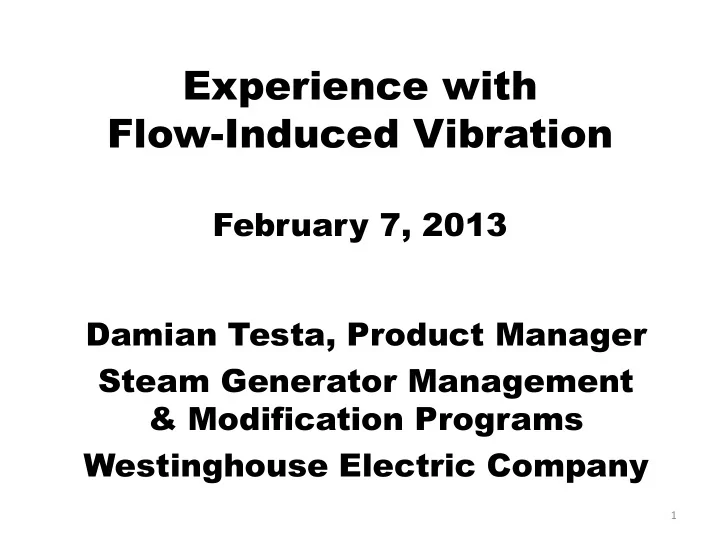

Experience with Flow-Induced Vibration February 7, 2013 Damian Testa, Product Manager Steam Generator Management & Modification Programs Westinghouse Electric Company 1
Design • Westinghouse has designed and manufactured steam generators (SGs) for 40+ years • Potential for flow-induced vibration (FIV) is routinely analyzed in every SG design – Tubes – Moisture Separators/Dryers 2
Design • Input parameters and methodologies used in FIV analysis are documented in the technical literature – Extensive testing performed to support analytical methodology 3
Design • Improvements in analytical methods have been made as operating experience and test data have evolved – Replacement steam generator (RSG) U-bend assemblies have incorporated design enhancements 4
Manufacturing • Field modifications have been effective in resolving original SG FIV issues – Complete anti-vibration bar (AVB) assembly replacement – Pre-heater modifications 5
Manufacturing • Westinghouse manufacturing processes have improved for RSGs and new SGs • Advanced AVB design since 1990s – Tighter dimensional controls on components – Improved assembly, oversight and documentation 6
Operating Experience • Original SGs – Good performance with few issues observed • A limited amount of AVB wear has been observed in different models • Some short-term rapid wear in early life due to manufacturing issues has been observed • Over the long term, with a few exceptions, AVB wear has not challenged pressure boundary integrity 7
Operating Experience • AVB replacements in 19 original SGs, implemented 1985 – 1993 – Effectively minimized AVB wear in Model 51 and one Model F plant by incorporating an expandable design – Other Westinghouse model SGs did not have wear issues 8
Operating Experience • Model D3 - FIV issues resulted in tube leak in a Westinghouse pre-heater SG design – Field modifications to divert flow in pre-heater • Model D4/D5 – Pre-heater wear not as severe as Model D3 (no tube leaks) – Tube expansion – Split feedwater flow 9
Operating Experience • Replacement SGs – No significant operational issues have been observed – A fraction of 1% of tubes have experienced AVB wear – Many Westinghouse RSGs have no AVB wear indications after one or more cycles of operation 10
Chronology of Significant FIV Issues • AVB Wear Resulted in Tube Leak (1983, Model 33) – Related to manufacturing issue • Pre-heater Wear (1983, Model D3) – Caused by turbulence and out- of-plane fluidelastic instability – Resolved by flow control modification and improved tube support 11
Chronology of Significant FIV Issues • Tube Rupture due to High Cycle Fatigue (1987, Model 51) – Caused by denting at top tube support and variation in AVB insertion depth – Addressed by analysis, the installation of sentinel plugs and stabilizers in a few tubes at some plants in response to NRC Bulletin 88-02 12
Chronology of Significant FIV Issues • Rapid AVB Wear (1992, Model F) – Related to manufacturing issue in one SG – Resolved by AVB replacement (improved gap control) 13
Recent SONGS RSG Experience • Westinghouse performed an evaluation for SONGS Unit 2 addressing tube wear at AVBs, tube-to-tube wear (TTW) and the potential for in-plane instability in the U-bend – Westinghouse concludes that TTW observed in two tubes in Unit 2 results from proximity of the tubes and out-of- plane vibration and/or in-plane turbulence and not from in-plane instability 14
Recent SONGS RSG Experience • Eddy current data shows: – No extension of wear scars beyond the width of the AVB, not only in these tubes, but other tubes in Unit 2 as well – Vibration due to in-plane instability will cause extension of the wear scars beyond the width of the AVB, as observed in Unit 3 • The two Unit 2 tubes with TTW have no indications of top tube support plate wear as found with tubes with in-plane instability in Unit 3 15
Recent SONGS RSG Experience – Westinghouse evaluation was documented in an operational assessment for the three degradation mechanisms 16
Summary • Westinghouse has observed issues related to FIV in the past in original SGs • As a result of our experience with tube wear and fatigue over the past two decades, we have incorporated enhanced design, manufacturing, and oversight into our RSGs and recent new SGs 17
Summary • Westinghouse strives for zero wear through our design and manufacturing; as a result, minimum wear has been observed • Tube wear in original SGs in service is managed in accordance with NEI 97-06 SG performance criteria • SGs satisfy performance criteria and are safe to operate 18
Recommend
More recommend